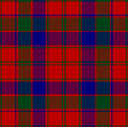
Clan Donnachaidh
Clan Donnachaidh Society
History
The chiefs are numbered from Duncan the Stout (stout in battle rather than in belly) who lived in the 1300s. He held lands in Rannoch and around Glen Errochty and took his followers to fight at Bannockburn in 1314 in support of his friend, King Robert the Bruce. His son Robert (perhaps called after Bruce) inherited land from his own mother and his estate ran from the edge of the Grampians to the gates of Perth.
Clan Donnachaidh, which means the children of Duncan, emerged from the union of the Scottish and Pictish kingdoms and counts amongst its forebears the Kindred of St. Columba. In 1437 the chief Robert Riach (grizzled) captured Sir Robert Graham who, with others, had just murdered the King James I at Perth. In reward James II gave Robert a charter in which all of his lands were made into a feudal barony giving him administrative control over them.
The main clan name and that of the chiefs is Robertson, but many other names taken by those descending from the chiefs or belonging to the families who lived on clan estates and sought the chief's protection can be considered septs of the clan. The most prominent are Duncan and Reid.

The kindred descend from Donnachaid Reamhar (Stout Duncan) de Atholia and are more properly named Clan Donnachaidh (Donnachie). He led the Clan at the battle of Bannockburn in 1314 where he fought for Bruce. The name ROBERTSON comes from the 4th Chief, Robert Riabhach (the grizzled). He became known as Robert Riach and in 1437 he captured Sir Robert Graham who had assassinated James 1st. In gratitude of this James 2nd made Robert's lands in Struan into a Barony in 1438. Robert died in 1460, from wounds received in battle, and was succeeded by his son Alexander. Throughout history the Clan maintained strong bonds with the Royal House and also with the Earldom of Atholl although in the 16th century much land was lost through debts incurred by the 8th Chief who was murdered in 1587. There were further financial problems in 1597 but in 1606 many of the lands were restored by the generosity of a loyal kinsman by the name of John Robertson who was a rich merchant in Edinburgh. The Robertson Chiefs remained loyal to the Stewarts and supported the Marquess of Montrose in all his battles. Two Chiefs died in quick seccession and the next, Alexander, was an eighteen year old student at St. Andrews University. He had been intended for the academic life and became known as the Poet Chief. However, he supported the Rising of 1688 but the defeat of James 7th, in 1690, saw his lands forfeited and he escaped into exile in France. An amnesty granted by Queen Anne in 1703 saw his return but he mustered his Clan in 1715 in support of the Old Pretender. He was twice captured and twice escaped, again fleeing to France. He took advantage of another amnesty in 1725 and again returned to Scotland but never did swear allegiance to the Hanovarians. He once more mustered the Clan in 1745 in support of Prince Charles Edward Stuart i.e. Bonnie Prince Charlie, but the Jacobite cause was finally defeated the next year at Culloden. He died in 1749 without an heir. The Chiefship passed to Duncan Robertson of Drumachine but by supporting the Jacobites their lands were again forfeited. Duncan's son Alexander became the 15th Chief and he lived to see all rights and lands i.e. the Darony of Struan, restored to him by the Crown in 1784. The 18th Chief, George, sold the Barony in 1854 but reserved, for himself and his heirs, the right to be buried in the family burial grounds. Threafter the Chiefs lived on their estates in Jamaica until eventually returning to a life of farming in Cranbrook in Kent.



